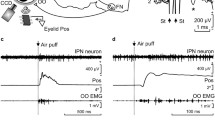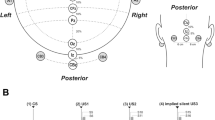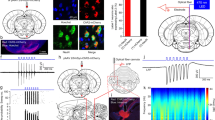Abstract
We examined the role of the cerebellum in classical conditioning of the nictitating membrane response (NMR) of rabbits by comparing the effects of unilateral and bilateral cerebellar cortical lesions. Using extended preoperative conditioning to ensure high levels of learning, we confirmed that unilateral lesions of lobules HVI and ansiform lobe impaired conditioned responses (CRs) previously established to an auditory conditioned stimulus, but did not prevent some relearning with post-operative retraining. Bilateral lesions of HVI and ansiform lobe produced similar impairments of CRs, but also prevented subsequent relearning. Unilateral cortical lesions produced significant enhancement of unconditioned response (UR) amplitudes to periorbital electrical stimulation. Bilateral cortical lesions enhanced UR amplitudes to a lesser extent. Because there was no correlation between the degree of CR impairment and UR enhancement across the unilateral and bilateral lesion groups, the suggestion that the lesions impaired CRs due to general effects upon performance, rather than due to losses of learning, is not supported. Both sides of the cerebellar cortex contribute towards learning a unilaterally trained CR. This finding is important for the re-interpretation of unilateral, reversible inactivation studies that have found no involvement of the cerebellar deep nuclei in the acquisition of NMR conditioning. In addition, we found conditioning-dependent modifications of unconditioned responses that were particularly apparent at low intensities of periorbital electrical stimulation. This finding is important for the re-interpretation of studies that have found apparent changes in the UR of conditioned subjects after cerebellar lesions.
Similar content being viewed by others
References
Albus JS (1971) A theory of cerebellar function. Math Biosci 10:25–61
Andersson G, Ekerot C-F, Oscarsson O, Schouenborg J (1987) Convergence of afferent paths to olivo-cerebellar complexes. In Glickstein M, Yeo C, Stein J (eds) Cerebellum and neuronal plasticity. Plenum, New York, pp 321–338
Brodal A, Kawamura K (1980) Olivocerebellar projection: a review. Adv Anat Embryol Cell Biol 64:1–140
Buisseret-Delmas C, Angaut P (1993) The cerebellar olivo-corticonuclear connections in the rat. Prog Neurobiol 40:63–87
Clark GA, McCormick DA, Lavond DG, Thompson RF (1984) Effects of lesions of cerebellar nuclei on conditioned behavioural and hippocampal responses. Brain Res 291:125–136
Disterhoft JF, Kwan HH, Lo WD (1977) Nictitating membrane conditioning to tone in the immobilized albino rabbit. Brain Res 137:127–143
Eccles JC, Ito M, Szentágothai J (1967) The cerebellum as a neuronal machine. Springer, Berlin Heidelberg New York
Gilbert PFC (1975) How the cerebellum could memorise movements. Nature 254:688–689
Gormezano I (1966) Classical conditioning. In: Sidowski JB (ed) Experimental methods and instrumentation in psychology. McGraw-Hill, New York
Gormezano I, Gibbs CM (1988) Transduction of the rabbit's nictitating membrane response. Behav Res Methods Instrum Comput 20:18–21
Gormezano I, Schneiderman N, Deaux E, Fuentes I (1962) Nictitating membrane: classical conditioning and extinction in the albino rabbit. Science 138:93–106
Gormezano I, Kehoe EJ, Marshall BS (1983) Twenty years of classical conditioning research with the rabbit. In: Sprague J, Epstein AN (eds) Progress in psychobiological psychology, vol 10. Academic Press, New York
Hardiman MJ, Yeo CH (1992) The effects of kainic acid lesions of the cerebellar cortex on the classically conditioned nictitating membranne response in the rabbit. Eur J Neurosci 4:966–980
Harvey JA, Welsh JP, Yeo CH, Romano AG (1993) Recoverable and non-recoverable deficits in conditioned responses after cerebellar cortical lesions. J Neurosci 13:1624–1635
Hesslow G (1994a) Correspondence between climbing fibre input and motor output in eyeblink-related areas in cat cerebellar cortex. J Physiol (Lond) 476:229–244
Hesslow G (1994b) Inhibition of classically conditioned eyeblink responses by stimulation of the cerebellar cortex in the decerebrate cat. J Physiol (Lond) 476:245–256
Hiraoka M, Shimamura M (1977) Neural mechanisms of the corneal blinking reflex in cats. Brain Res 125:265–275
Howell DC (1992) Statistical methods for psychology, third edition, Duxbury Press, Belmont, USA
Ito M (1982) Cerebellar control of the vestibulo-ocular reflex — around the flocculus hypothesis. Ann Rev Neurosci 5:275–296
Ivarsson M, Hesslow G (1993) Bilateral control of the orbicularis oculi muscle by one cerebellar hemisphere in the ferret. Neuroreport 4:1127–1130
Krupa DJ, Thompson JK, Thomspon RF (1993) Localization of a memory trace in the mammalian brain. Science 260:989–991
Larsell O (1970) The comparative anatomy and histology of the cerebellum from monotremes through apes. University of Minnesota Press, Minneapolis
Lavond DG, Steinmetz JE, Yokaitis MH, Thompson RF (1987) Reacquisition of classical conditioning after removal of cerebellar cortex. Exp Brain Res 67:569–593
Lavond DG, Kanzawa SA, Ivkovich D, Clark RE (1994) Transfer of learning but not memory after unilateral cerebellar lesion in rabbits. Behav Neurosci 108:284–293
Marchetti-Gauthier E, Meziane H, Devigne C, Soumireau-Mourat B (1990) Effects of bilateral lesions of the cerebellar interpositus nucleus on the conditioned forelimb flexion reflex in mice. Neurosci Lett 120:34–37
Marr D (1969) A theory of cerebellar cortex. J Physiol (Lond) 202:437–470
McCormick DA, Thompson RF (1984a) Cerebellum: essential involvement in the classically conditioned eyelid response. Science 223:296–299
McCormick DA, Thompson RF (1984b) Neuronal responses of the rabbit cerebellum during acquisition and performance of a classically conditioned nictitating membrane-eyelid response. J Neurosci 4:2811–2822
McCormick DA, Lavond DG, Clark GA, Kettner RE, Rising CE, Thompson RF (1981) The engram found? Role of the cerebellum in classical conditioning of the nictitating membrane and eyelid response. Bull Psychon Soc 18:103–105
Miles TS, Wiesendanger M (1975a) Organization of climbing fibre projections to the cerebellar cortex from trigeminal cutaneous afferents and from the SI face area of the cat. J Physiol (Lond) 245:409–424
Miles TS, Wiesendanger M (1975b) Climbing fibre inputs to cerebellar Purkinje cells from trigeminal cutaneous afferents and the SI face area of the cerebral cortex in the cat. J Physiol (Lond) 245:425–445
Nagao S, Ito M, Karachot L (1984) Site in rabbit flocculus specifically related to eye blinking and neck muscle contraction. Neurosci Res 1:149–152
Nordholm AF, Thompson JK, Dersarkissian C, Thompson RF (1993) Lidocaine infusion in a critical region of cerebellum completely prevents learning of the conditioned eyeblink response. Behav Neurosci 107:882–886
Schreurs BG, Oh MM, Hirashima C, Alkon DL (1995) Conditioning-specific modification of the rabbit's unconditioned nictitaing membrane response. Behav Neurosci 109:24–33
Skelton RW (1988) Bilateral cerevellar lesions disrupt conditioned eyelid responses in unrestrained rats. Behav Neurosci 102:586–590
Steinmetz JE, Lavond DG, Ivkovich D, Logan CG, Thompson RF (1992) Disruption of classical eyelid conditioning after cerebellar lesions: damage to a memory trace system or a simple performance deficit? J Neurosci 12:4403–4426
Thompson RF (1986) The neurobiology of learning and memory. Science 233:941–947
van Ham JJ, Yeo CH (1992) Somatosensory trigeminal projections to the inferior olive, cerebellum and other precerebellar nuclei in rabbits. Eur J Neurosci 4:302–317
Welsh JP (1992) Changes in the motor pattern of learned and unlearned responses following cerebellar lesions: A kinematic analysis of the nictiating membrane reflex. Neuroscience 47:1–19
Welsh JP, Harvey JA (1989) Cerebellar lesions and the nictitating membrane reflex: performance deficits of the conditioned and unconditioned response. J Neurosci 9:299–311
Welsh JP, Harvey JA (1990) Associative learning requires the function of the inferior olive. Am Soc Neurosci Abstr 16:268
Welsh JP, Harvey JA (1991) Pavlovian conditioning in the rabbit during inactivation of the interpositus nucleus. J Physiol (Lond) 44:459–480
Woodruff-Pak D, Lavond DG, Thompson RF (1985) Trace conditioning: abolished by cerebellar nucleus lesions but not lateral cerebellar cortex aspirations. Brain Res 348:249–260
Yeo CH (1987) Cerebellum and classical conditioning. In: Glickstein M, Yeo C, Stein J (eds) Cerebellum and neuronal plasticity. Plenum, New York, pp 321–338
Yeo CH, Hardiman MJ (1992) Cerebellar cortex and eyeblink conditioning: a reexamination. Exp Brain Res 88:623–638
Yeo CH, Hardiman MJ, Glickstein M (1984) Discrete lesions of the cerebellar cortex abolish the classically conditioned nictitating membrane response of the rabbit. Behav Brain Res 13:261–266
Yeo CH, Hardiman MJ, Glickstein M (1985a) Classical conditioning of the nictitating membrane response of the rabbit. I. Lesions of the cerebellar nuclei. Exp Brain Res 60:87–98
Yeo CH, Hardiman MJ, Glickstein M (1985b) Classical conditioning of the nictitating membrane response of the rabbit. II. Lesions of the cerebellar cortex. Exp Brain Res 60:99–113
Yeo CH, Hardiman MJ, Glickstein M (1985c) Classical conditioning of the nictitating membrane response of the rabbit. III. Connections of cerebellar lobule HVI. Exp Brain Res 60:114–126
Yeo CH, Hardiman MJ, Glickstein M (1986) Classical conditioning of the nictitating membrane response of the rabbit. IV. Lesions of the inferior olive. Exp Brain Res 63:81–92
Zimny R, Grottel K, Jakielska D, Ostrowska A (1989) Topographic and zonal pattern of olivocerebellar projection to the paramedian lobule in the rabbit: an experimental study with an HRP retrograde tracing method. Neurosci Res 7:173–198
Author information
Authors and Affiliations
Rights and permissions
About this article
Cite this article
Gruart, A., Yeo, C.H. Cerebellar cortex and eyeblink conditioning: bilateral regulation of conditioned responses. Exp Brain Res 104, 431–448 (1995). https://doi.org/10.1007/BF00231978
Received:
Accepted:
Issue Date:
DOI: https://doi.org/10.1007/BF00231978




